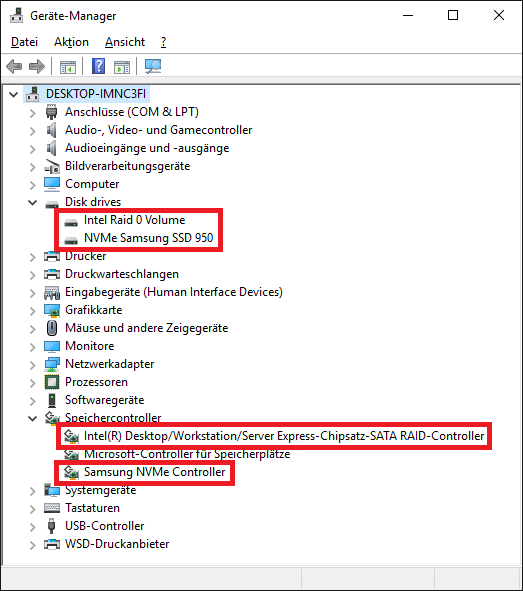@nick29 :
Thanks for your report, which verifies, that the Samsung 950 Pro NVMe SSD has a LEGACY mode NVMe Option ROM on board, whereas the related chip of the Samsung SM951 NVMe SSD doesn’t contain such module.
Motherboard sees it as an ide drive. it’s also a bit faster than the sm951 ahci too.All my drivers though say that there from 21/06/2006.Not shure why…Attaching some crystal disk mark results
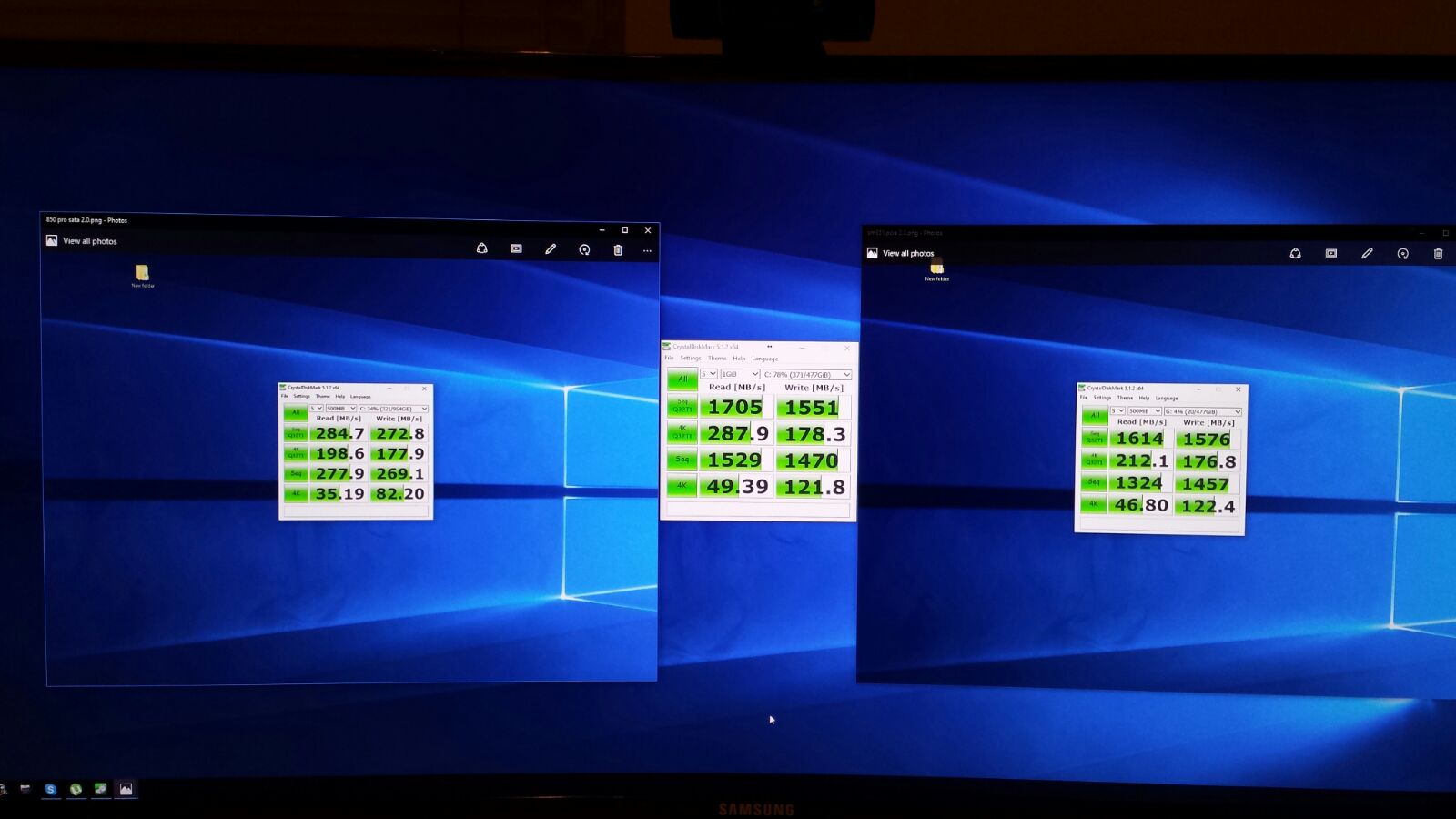
Where do you see "IDE"? Within the BIOS?
Which "drivers" do you mean? The shown date is absolutely wrong and misleading.
All "Disk drives", which are listed within the Device Manager, are using the MS in-box driver named disk.sys, which is up-to date, but when you are doing a right click onto any of the listed disk drives and choose the options "Properties" > "Driver", you will see something like this:
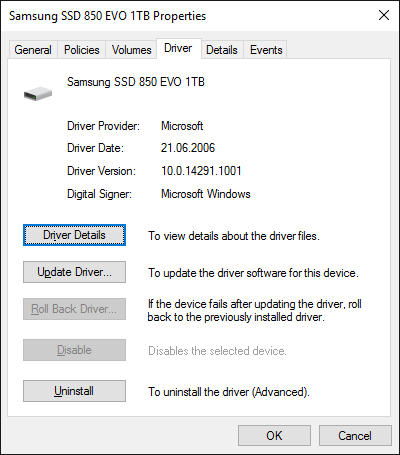
That the shown date 06/21/2006 is absolutely wrong can be verified by the shown driver version. In my case it is 10.0.14291.1001, the version number of the latest Win10 Insider Preview Build dated 03/15/2016.
Note: The Device Manager doesn’t show the real date of the driver, but just the driver date, which has been written into the associated information (= text) file named *.inf. In this case Microsoft forgot to customize the date entry within the associated disk.inf:
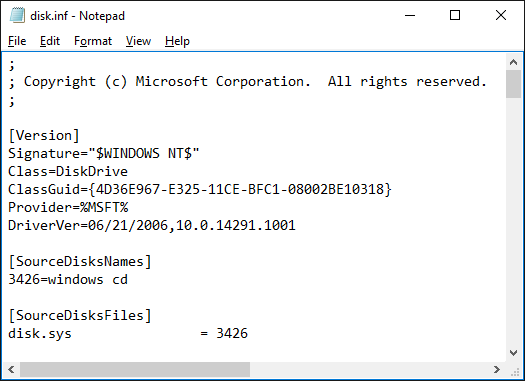
Yes within the bios … 850 pro is showing up as ahci. Getting ridiculous results with the 850 pro in rapid mode.Would that really make it faster than the 950 pro in real world…? Ok so i definitely installed the nvme driver from samsungs site. Hopefully people with older boards will benefit from this and get the same result. Thanks Fernando and PPCnostalgic for all you help 
Nick, just my curiosity but does your 950Pro load its own Bios alongside your motherboard one?
How would i check that? I can definetely see the bios finding the drive as an ide drive and all my other hd’s come up as HDD and the model.Is there another way to check this?
Thank you for replying. If you don’t see SM950Pro firmware boot screen after your motherboard Bios the answer to my previous question is no. BTW my SM951 isn’t seen by the Bios but when system is booted it shows up the drive as internal Sata express device with PCI x4 connection. Mac OS X installer lets me install on the SM951 as it lists the drive as bootable device… Anyway it’s good to ear you solved too by swapping your SSD with a 950Pro, these old X58 mobos are still great boards despite their age.
Logically if it works on mine it should ![]() work with other x58’s too maybe
work with other x58’s too maybe ![]()
You’re right. Just for fun I’ve tried to overclock the PCI bus frequency too, now it’s 110Mhz instead of 100(stock). Benchmarking the SM951 now I get a bump about 15percent speed, I’m running the system since a week with this PCI frequency with no issues…
950 PRO raid 0 anyone ![]()
EDITED: December 2nd 2017, To try and help this threads first 10 pages make more sense to everyone. The first 10 pages, from post #2 to post #151 are in fact BEFORE post #1 was created (the OP).
On December 2nd of 2017 this thread was merged with a brand new 2017 updated DUET method put together by the developer “noInk” that comes with a REFIND GUI Boot Manager included. Although the Samsung 950 NVMe SSD was since found to contain built-in legacy mode booting (can be used on legacy BIOS without any fancy UEFI aware boot managers), it too can be used with the OP’s DUET. In fact practically ANY storage device can be booted using this DUET, so long it can see the partition type the OS is using (read post #1 for more info).
Because this thread was merged with a brand new DUET thread on 12-2-2017 that solves all of our original nvme boot problems, you will find all posts in the first 10 or so pages that don’t seem to make much sense with the subject matter from post #1. So please just be aware of that.
If you want to jump straight to the MAJOR post that solves many, if not all of our problems here, just jump to post #147 in this thread. That is where noInk originally released his REFIND enabled GUI version of DUET. Remember, REFIND and DUET are the products of other developers that are given credit in post #1, and the license information will be found there. noInk just put the pieces together for us and he deserves the credit for that work.
Thank you @noInk for the fantastic work on your version of DUET
Thank you @Fernando for giving us the platform to spread these wonderful ideas, and for his general IT help.
If I should ever have the required time to do it, I will test this configuration (Samsung 950 Pro as bootable system drive and an Intel RAID array as storage drive) with my Z68 and Z97 systems.
Maybe such NVMe-RAID combination is generally problematic with (older?) Intel chipset systems.
Since I had the required time, I just have tested the following configuration:
- Mainboard: ASRock Z97 Extreme6
- Chipset: Intel Z97
- OS: Win10 x64
- System Drive: 256 GB Samsung 950 Pro SSD (using the NVMe protocol), PCIe connected via M.2>PCIe adapter
- Storage Drive: 2x256 GB Samsung 840 Pro as Intel RAID0, connected to the first Intel SATA3 ports 0+1
- BIOS settings: “RAID” enabled, “Fast Boot” disabled, “CSM” enabled
Result:
The chosen combination worked, that means:
- The system booted automaticly into the OS Win10 x64, which had been installed in UEFI mode some weeks ago onto the Samsung 950 Pro.
- The RAID0 array had been automaticly detected by the OS and its data were accessible from within the File Explorer.
- The Disk Management showed the RAID0 array as 1 drive.
But:
- The Device Manager listed the Intel SATA AHCI Controller (within the “IDE ATA/ATAPI Controllers” section).
- The “Storage Controllers” section of the Device Manager didn’t contain the Intel SATA RAID Controller.
- The Intel RAID Utility was not accessible, neither via CTRL+I nor from within the UEFI BIOS.
- After having rebooted the UEFI BIOS settings within the “BOOT” section had been changed automaticly (“Fast Boot” was now enabled, “CSM” disabled).
- I tried to restore the previous BIOS settings, but was not able to boot into the OS anymore.
Here are the pictures of the Device Manager and the Disk Management:
[[File:Device Manager - Samsung 950 Pro NVMe + RAID0 on Z97.png|none|auto]][[File:Disk Management - Samsung 950 Pro NVMe + RAID0 on Z97.png|none|auto]]
My test verifies, that the simultaneous usage of a Samsung 950 Pro SSD (as bootable system drive) and an Intel RAID0 array (as storage drive) on an Intel Z97 chipset system may work, but obviously not properly.
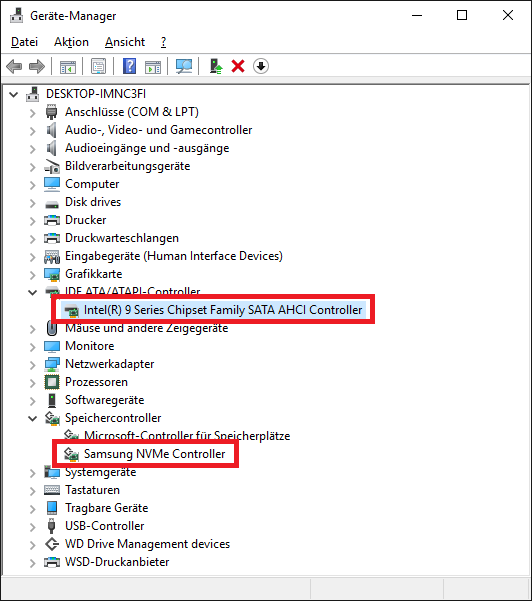
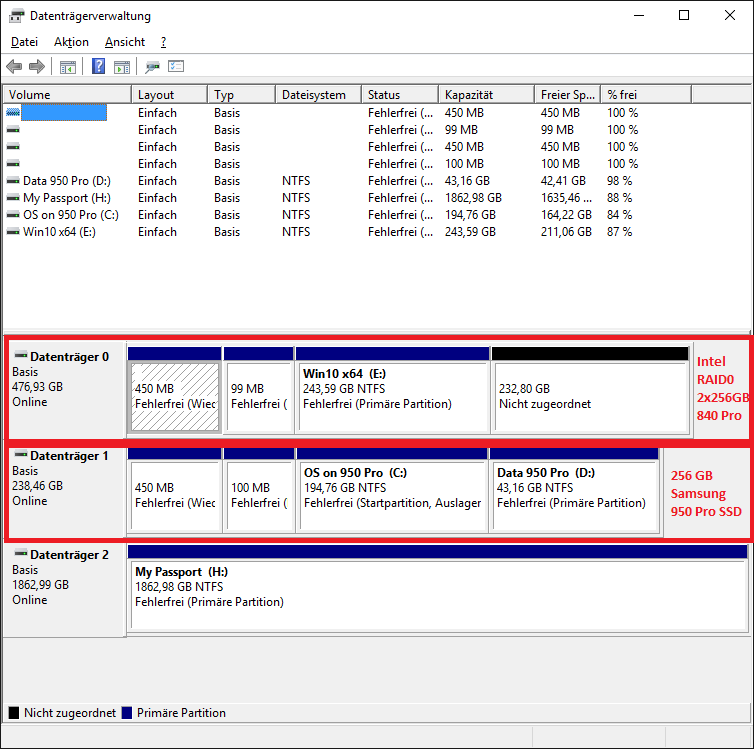
After having gotten the interesting results with the Samsung 950 Pro as system drive in combination with an Intel RAID0 array (see my previous post), I had the idea to redo a rather similar test by using my Samsung SM951 NVMe as system drive instead.
This was the configuration:
- Mainboard: ASRock Z97 Extreme6
- Chipset: Intel Z97
- OS: Win10 x64, recently installed in UEFI mode
- System Drive: 256 GB Samsung SM951 NVMe, connected via M.2 (I don’t think, that it matters, that I didn’t use the M.2>PCIe adapter)
- Storage Drive: 2x256 GB Samsung 840 Pro as RAID0 array, connected to the first Intel SATA3 ports 0+1
- BIOS settings: “RAID” enabled, “Fast Boot” enabled, “CSM” disabled (
I don’t believe, that these changed BIOS settings had any influence on the test result).
Results:
The chosen combination worked fine:
- The system booted automaticly into the OS Win10 x64, which had been installed some days ago onto the Samsung SM951 NVMe.
- The RAID0 array had been automaticly detected by the OS and its data were accessible from within the File Explorer.
- The Disk Management showed the RAID0 array as 1 drive.
- New: The Device Manager didn’t list any AHCI Controller. The “IDE ATA/ATAPI Controller” section was missing!
- New: Within the “Storage Controllers” section the Device Manager now additionally contained the expected Intel SATA RAID Controller.
- New: Within the UEFI BIOS the “Intel(R) Rapid Storage Technology” tab was visible and the related Utility 100% usable.
- New: Even after some reboots everything worked fine and no BIOS settings were altered by the system.
Here are the related pictures:
[[File:Device Manager - Samsung SM951 NVMe + Intel RAID0.png|none|auto]][[File:Disk Management - Samsung SM951 NVMe + Intel RAID0.png|none|auto]]
[[File:UEFI BIOS - Samsung SM951 + Intel RAID0 Pic1.png|none|auto]][[File:UEFI BIOS - Samsung SM951 + Intel RAID0 Pic2.png|none|auto]]
Conclusion:
My test results verify, that
a) it is generally possible to use a PCIe/M.2 connected NVMe SSD as bootable system drive and an Intel RAID array as data storage drive, but
b) this combination
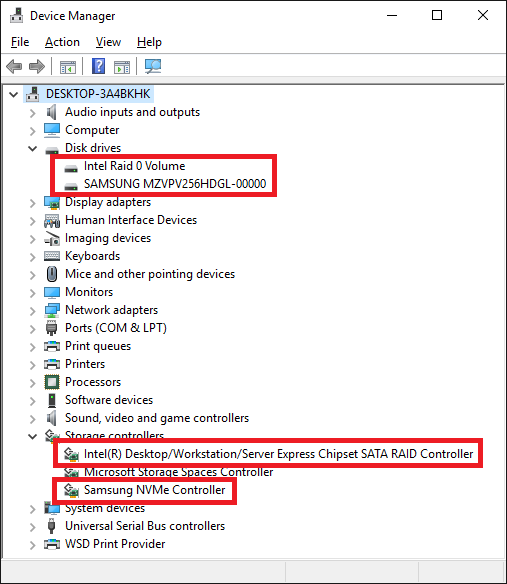
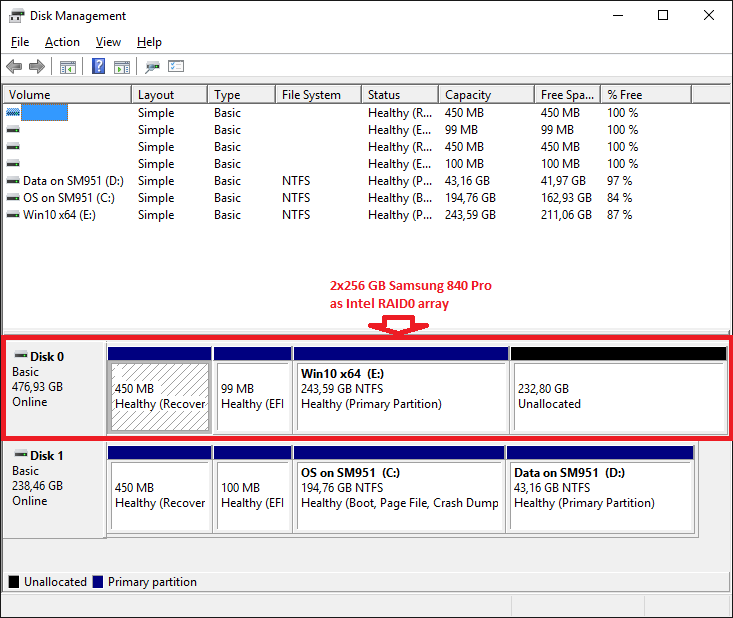
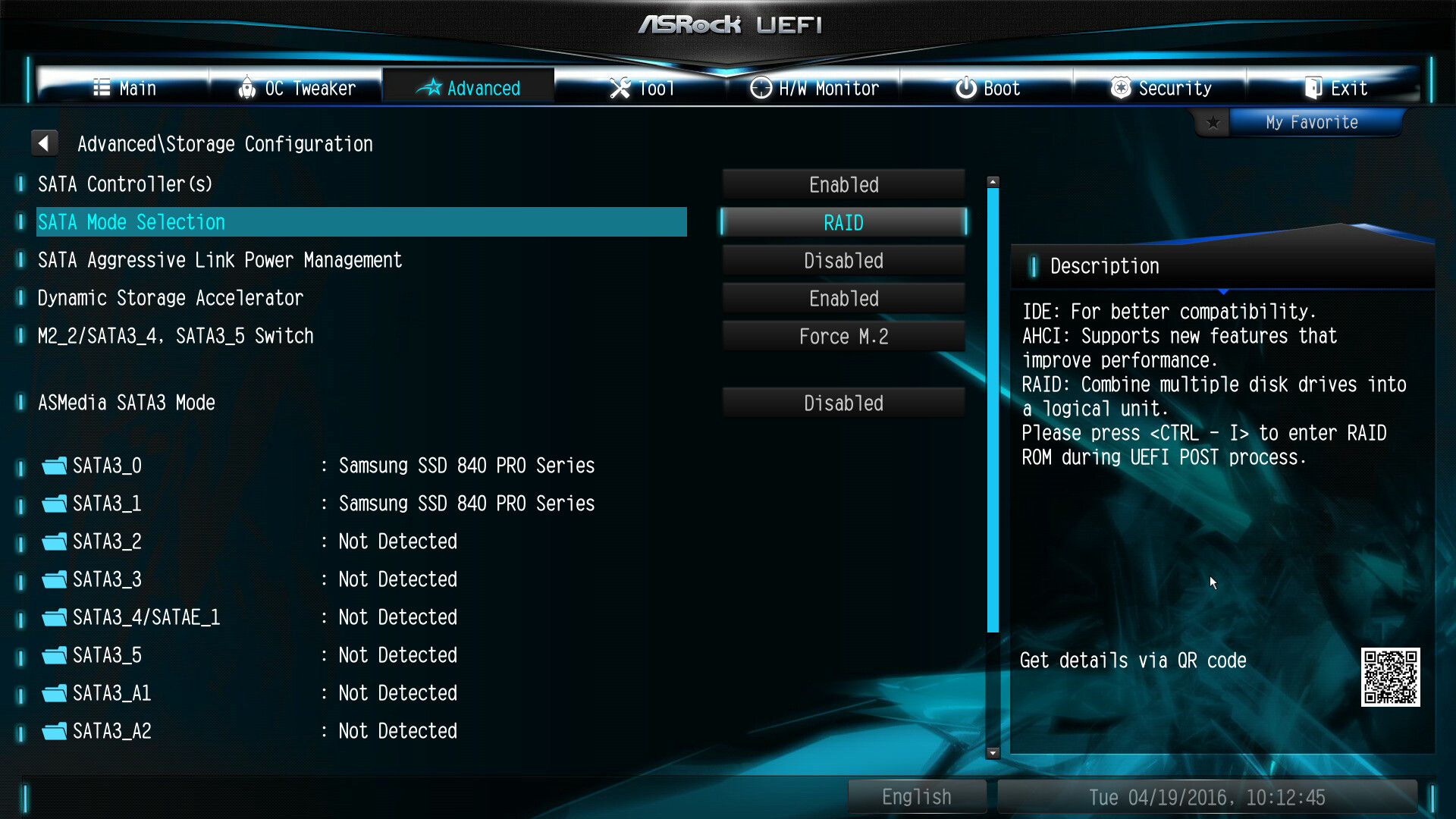
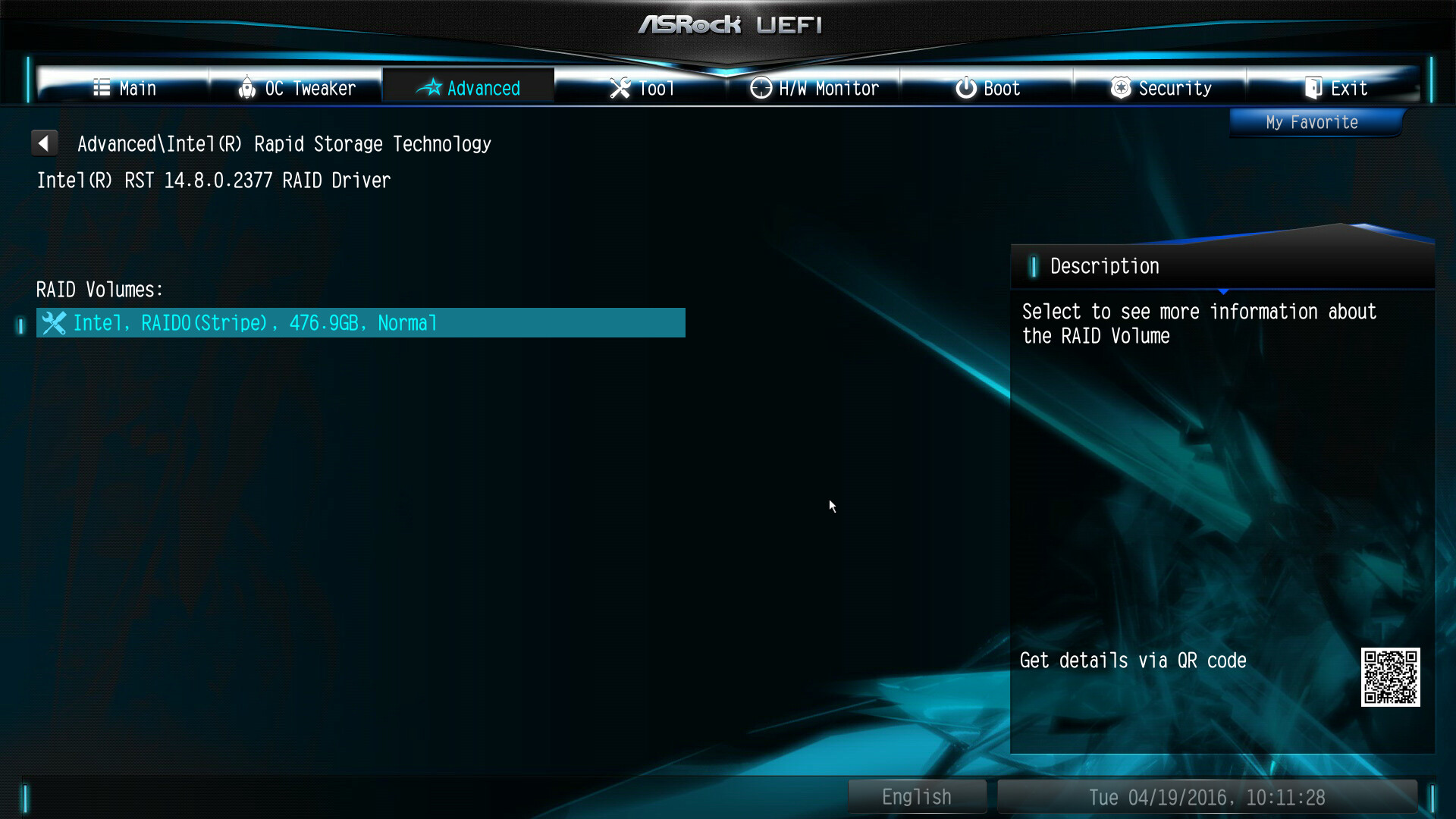
After having done an additional test with the formerly used Samsung 950 Pro NVMe SSD in "clean" UEFI mode ("CSM" disabled), I have to admit, that I was wrong regarding this statement.
With these altered BIOS settings everything worked fine even with the combo Samsung 950 Pro + Intel RAID0.
Here is the picture of the Device Manager, which verifies the success:
[[File:UEFI mode - Device Manager - Samsung 950 Pro NVMe + RAID0 on Z97.png|none|auto]]
Considering this is a x58 thread I am wondering if we with legacy bios would get the same results? In fact, if it’s true that 950 pro has a built-in legacy option ROM how does two of them in the same system even work? And would that option ROM even have a raid menu? Lol
After 20 years of raiding drives I admit I am starting to finally lose my interest in doing so. These new SSD’s are just satisfying my need for speed as they are. I wish I had one 950 pro 512gb for the OS and one Intel 750 for the local storage. That would be fun to test.
After having done my tests I am pretty sure, that it is impossible to get the combo Samsung 950 Pro + Intel RAID0 properly working with any non-UEFI BIOS system.
About which 2 Option ROM modules are you talking? The Option ROM, which is within the Samsung 950 Pro, has nothing to do with a RAID menu and the Intel RAID ROM, which is within the mainboard BIOS.
You will spend a lot of money and see brilliant benchmark test results, but I doubt, that you will realize a big difference while doing your daily work besides video encoding or copying extremely big files.
I doubt that too. I will keep my Sabertooth x58 for now with Plextor M6e PCIe x2 as AHCI Boot device (quite fast and without any problems), Kingston HyperX Predator PCIe x4 for working and RAID5 ICY-Box on USB 3.0 as storage/streaming
What I meant was, the controllers usually have a menu such as intels which you access via cntrl-I, and the marvel option ROM
Also can be accessed via cntrl-M and it also has a raid menu that can be setup for raid functions. So I wonder if the 950 pro also has something similar in its option ROM, maybe cntrl-S to access the features of its controller, such as legacy raid. Or is it just a dumbed down option ROM you cannot access within the storage controller?
My thoughts are, that Bootable raid is not possible and the only PCIe raid possible on legacy systems would therefor be windows raid. But I’m still wondering how nick29’s 950 pro option ROM works on his legacy bios.
No, there is no NVMe menu, which splashes up while booting. Why should it? There is nothing to create or to configurate like a RAID array.
All Option ROM modules are LEGACY mode BIOS modules. Some NVMe SSDs have an NVMe Option ROM within their chip.
